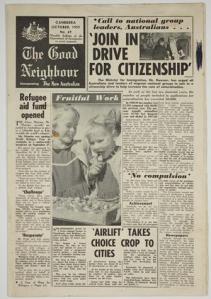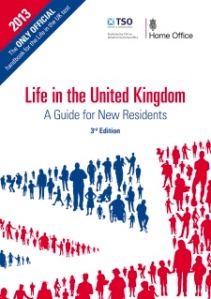As a migrant and a historian of migration, there are many moments when events in my personal life overlap with my research. This has never been more so than in the last month, where I have started an exciting new project on migrants and health in post-war Australia, funded through a Wellcome Trust Research Fellowship in Medical Humanities, and begun the journey towards citizenship in Britain through taking the Life in the UK test.
The Life in the UK test is something of a right of passage amongst Australians in London. Previously a prerequisite only for citizenship, it is now a requirement for all applying for indefinite leave to remain (permanent residency), most of whom are already resident in the country on a range of visas, including work and spouse visas. The 24 questions test the applicant’s knowledge of British traditions and customs – a pass is 75% correct or above. Australians, like others from English-speaking or Commonwealth countries, are exempt from a separate language test. So for us, it’s a small hoop to jump though – after all, Australia is a country with similar institutions, culture and traditions. How hard could it be? (if you are wondering, you can take a short version of the test here)
I borrowed the official ‘Life in the UK: A Guide for New Residents’ from a friend and dutifully began reading about Britain’s ‘long and illustrious history’. Meanwhile, in the library each day I was reading about Australia’s post-war immigration programme. With a strong preference for British migrants – deemed the most assimilable and the best migrant ‘stock’ – the programme would eventually see millions of European migrants arrive alongside the Brits, including Italians, Greeks, Turks, Yugoslavs, and some 170,000 Displaced Persons from eastern and central Europe, assisted through a scheme with the International Refugee Organisation (IRO). Although the ‘northern Europeans’ were preferred, and thus received more assistance to migrate, the entry of so many ‘southern Europeans’ was tolerated and even begrudgingly encouraged in a bid to shore up Australia’s population and economy. To assuage concerns of the host population, the newly-formed Department of Immigration dubbed the diverse migrants ‘New Australians’. A nationwide organisation, the Good Neighbour Movement, was tasked with introducing them to the ‘Australian Way of Life’, and encouraged them to naturalize by taking up Australian Citizenship as soon as they were eligible. Throughout most of the period I am looking at, five-years of residency was required before applying.
The hoops these migrants were expected to jump through were much tougher than the ones I was negotiating. Migration agreements with the IRO and many individual countries required migrants to sign two-year work contracts in return for their assisted passages, with the type and location of the work at the discretion of the government. International qualifications were rarely recognised. Family reunion was not guaranteed. Even the government work contracts did not ensure employment, leading to a number of riots in migrant hostels. Migrants were expected to get on with becoming Australians, in their attitudes, language, knowledge and behaviour, and above all else, to be grateful for the opportunity to build new lives. The doctrine of assimilation guided these expectations. As Australian demographer W.D. Borrie explained in 1954:
Assimilation is a psychological, socio-economic and cultural process, resulting in the progressive attenuation of differences between the behaviour of immigrants and nationals within the social life of a given country.

‘The Good Neighbour’, monthly bulletin of the Good Neighbour Movement, promoting citizenship in 1959.
The aim of assimilation would be achieved when it was impossible to tell the ‘immigrant’ from the ‘national’. Naturalization was seen as the reward, or perhaps as the proof, for achieving such invisibility. But the take-up rates for citizenship among some groups of migrants remained low throughout the 1950s and 1960s. In the immediate post-war world, assimilation represented a progressive attitude to immigrant settlement, one that was embraced by organisations like the Intergovernmental Committee for European Migration (ICEM). But ultimately the impracticality of the doctrine became impossible to ignore. In 1964 the Australian Government shifted their language from ‘assimilation’ to the softer, apparently more accommodating ‘integration’, and the 1970s saw ‘multiculturalism’ adopted as a new national ideology. But as Anna Haebich and others have argued, the ideal of assimilation still plays into current debates about national identity, citizenship, and immigration. Haebich’s concept of ‘retro-assimilation’, or a longing for a simpler (albeit fictional) cohesive past, is one that I kept coming back to when preparing for my Life in the UK test:
Retro-assimilation mixes 1950s dreams of an assimilated nation with current ideas of nationhood using today’s spin to create an imagined world based on shared values, visions and agreements where all citizens will be treated equally and the same and share fully in the benefits of Australian society, once they agree to cast off their differences and become the same… Retro-assimilation has strong appeal in today’s climate of social turmoil, transformation and global threats: we are irresistibly drawn to its retro-scapes, its nostalgic memories of safer and simpler times.
In both Britain and Australia the tests now sat by prospective citizens condense complex and contested histories into much simpler pasts and presents, peppered with famous sportsmen and women, inventors and artists. Citizenship requires knowledge of these national heroes and their achievements, as well as a smattering of demographic info and random facts about the political process (I now know, for instance, how many people sit on a jury in Scotland. It’s 15). A current research project, ‘The UK Citizenship Process: Understanding Immigrants’ Experiences‘ at the University of Leicester is looking at the ‘assimilationist turn’ in British immigration and integration policies, though the experience of those who are at the receiving end of policy change – immigrants themselves. In my historical research on migrants and health in assimilation-era Australia, I also want to look at sources that reveal migrants’ experiences, rather than just policy-makers’ intentions.
In the meantime, I am celebrating jumping through the first hoop and passing the Life in the UK test (phew!), and will now always remember what date St George’s Day falls on. Whether or not I will decide to take up citizenship is another matter, but unlike many of the migrants I am studying, I will have the option to retain the citizenship of my country of birth as well. An excerpt from a Greek newspaper in Australia in the 1960s serves as a reminder of the pressure on migrants to naturalize, the permanent nature of the decision, and its emotional implications, and seems a fitting note to end on:
Four and five years is hardly sufficient time in which a man of sound principles could, without strong pangs of conscience, sever every link with what he has been taught to hold dear… It is only after many years of separation from the mother country, and in the absence of any circumstances and situations which may remind a man of it, that he begins to attach diminishing importance to his national ties. It is then that he finds the thought of returning home has lost much of its pressing attractiveness. And it is then that the idea of legally adopting the country, in which he now lives and prospers, strikes him in earnest.
Sources:
W.D. Borrie, Italians and Germans in Australia, Cheshire: Melbourne, 1954.
Anna Haebich, Spinning the Dream: Assimilation in Australia 1950 – 1970, Fremantle Press: North Fremantle, WA, 2008.
Hellenic Herald editorial, quoted in George Zubrzycki, ‘Migrants: Some become citizens’, The Canberra Times, Thursday 23 June 1966.

